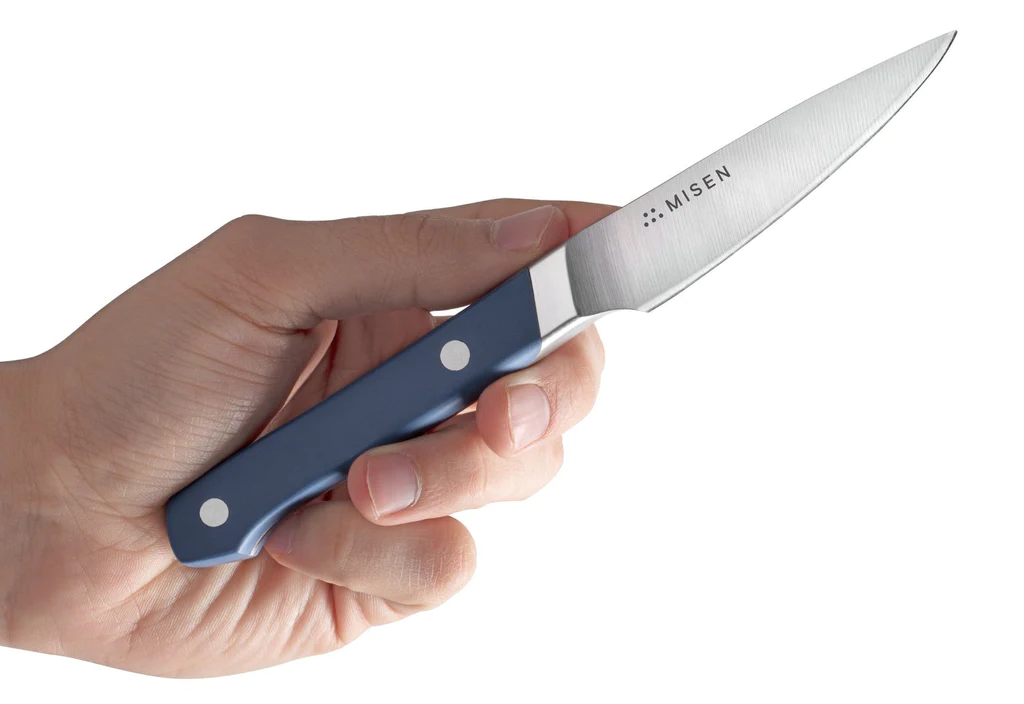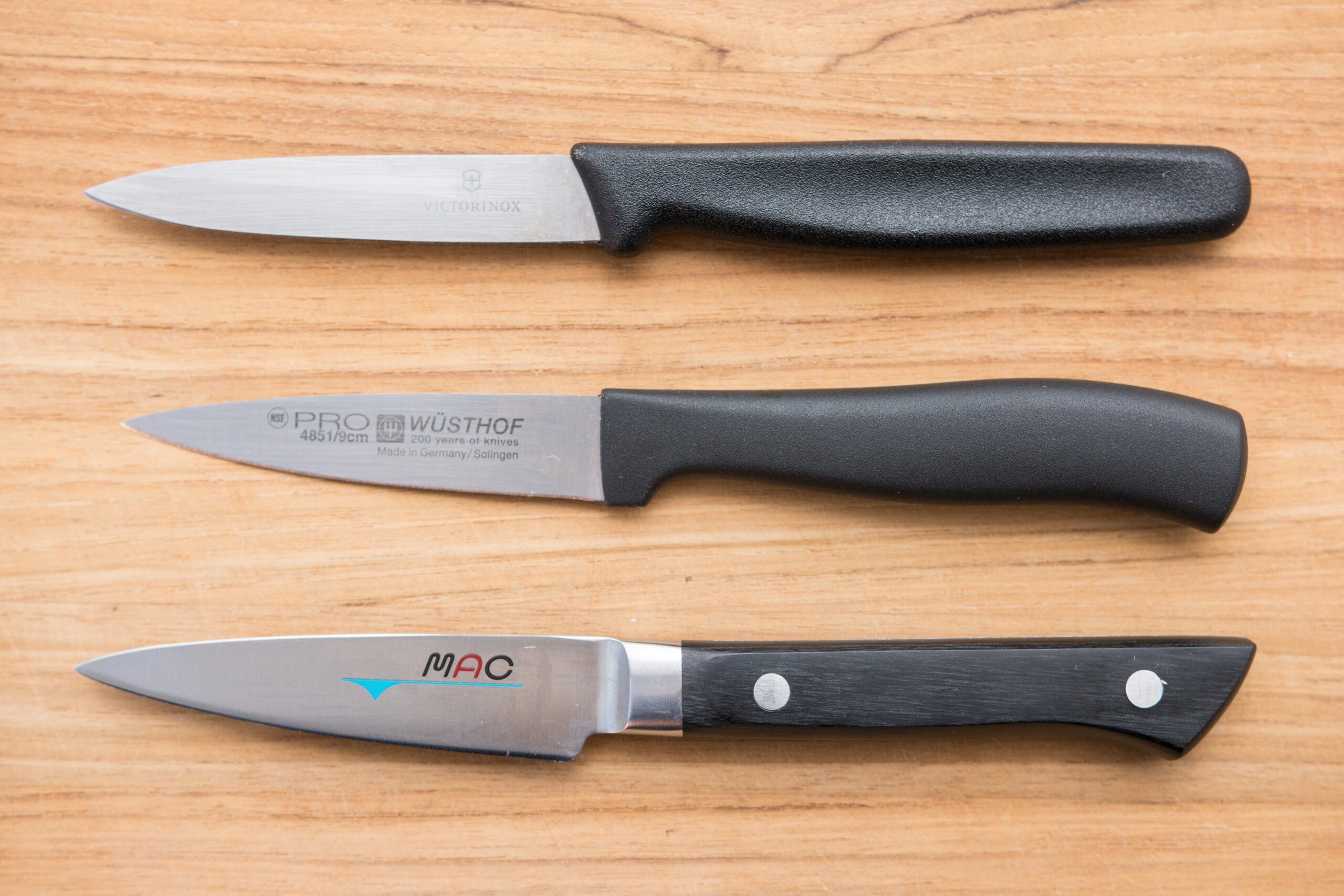Last updated on January 20th, 2024 at 08:13 am
Paring knives are flexible, precision-cutting tools in the culinary arts. Chefs need this little, agile knife. It excels at delicate tasks with its sharp blade and mobility.
This detailed guide will cover paring knives’ features, usage, and upkeep. Let’s explore this essential kitchen tool’s secrets!
What Is a Paring Knife?
A paring knife, also called a peeling knife, is a small knife with a 2–4-inch blade. Its pointed tip and sharp cutting surface allow for precision and agility while working with fragile materials.
The blade is made of high-quality stainless steel or carbon steel, ensuring durability and a sharp edge.
The Anatomy of a Paring Knife

Several critical parts make a paring knife functional and effective. Understanding the parts of a paring knife can help you choose one for your culinary projects and appreciate its design.
Blade: Paring knife blades cut. High-quality stainless steel or carbon steel is used. The thin, narrow blade is 2 to 4 inches long. This tiny profile makes cutting small, delicate ingredients precise and controlled.
Paring knife point: The blade tip. For peeling, trimming, and scoring, it’s sharp and tapered. The sharp tip offers perfect control over curves and shapes, making it suitable for precise and delicate applications.
Blade: Paring knives chop food with their serrated edges. Its razor-sharp edge makes slicing easy. Depending on the manufacturer and knife use, the edge might be straight or slightly curved.
Spine: The back of a paring knife is called the spine. The thicker, non-sharpened blade adds stability and robustness. The spine guides pressure when cutting, improving control and precision.
Handle: Paring knives are held by their handles. Its ergonomic shape makes it easy to carry for long periods of time. Wood, plastic, or composite paring knife handles are typical. Optimal control and mobility require a balanced handle.
Bolster: The broad blade-handle juncture is the bolster. It balances and stabilizes the knife. The bolster strengthens the knife and prevents your hand from touching the blade.
Tang: The blade’s handle-extending tang. It might be full-tang or partial-tang. Full-tang structure is preferred for its durability and strength.
The Versatility of Paring Knives

Pruning and Peeling
Peeling fruits and vegetables is easy with a paring knife’s narrow blade and pointed tip. A paring knife gives you precise control when peeling an apple or garnishing a cocktail, reducing waste and improving presentation.
Complex Designs
Paring knives excel at decorative cutting. It lets chefs and home cooks cut elaborate designs on fruits and vegetables. Adding aesthetic flourish to dishes with radish roses and citrus zests requires a paring knife.
Seed Removal/Coring
Many fruits and vegetables need seeds or cores removed. Paring knives’ sharp tips make coring apples, pears, and other fruits easier. A paring knife’s precision lets you quickly remove undesired pieces without damaging the ingredient.
Fine Detail
A paring knife’s nimbleness shows while deveining shrimp, cutting fat, or slicing garlic into small, uniform pieces.
Its compact size and sharp blade enable precise detail work that other knives cannot. A paring knife is essential for sautéing garlic and deveining shrimp for display.
Making Garnishes
A paring knife’s accuracy lets you make radish rosettes and carrot curls. A paring knife lets you be creative when garnishing a salad, cocktail, or cake.
Score and Score
Score meat with a paring knife. Shallow cuts let marinades and flavors into the meat, making it more flavorful and tender. A sharp paring knife helps infuse flavor into roasts, chickens, and duck breasts.
Maintaining Your Paring Knife

Proper maintenance is essential for a long-lasting paring knife. Paring knife maintenance tips:
Handwash Only: Harsh detergents and high heat might damage the blade and handle of your paring knife. Hand-wash it with mild soap and warm water. To avoid dampness, dry it immediately.
Sharpening: Precision cutting requires a sharp paring knife. Sharpen the blade periodically using a good knife sharpener or stone. Sharp knives boost performance and reduce accidents.
Safe Storage: Store your paring knife in a knife block or sheath to prevent cuts. Avoid throwing it into a utensil drawer where other sharp objects may dull or ruin it.
Avoid Hard Surfaces: Paring knives are made for delicate cutting jobs, not bones, frozen foods, or hard surfaces. Such misuse can damage or injure your paring knife. These jobs require the right tool.
Questions (FAQs)
A paring knife for larger cuts?
Paring knives can be utilized for heavier cutting operations if needed. For major cutting operations, its tiny size may take more work and time. Chef’s knives and utility knives are better for such jobs.
Left-handed paring knives?
Right-handed and left-handed people can use paring knives. Find symmetrical knives with comfortable grips for both hands. Some manufacturers make beveled left-handed paring knives.
Paring knife sharpening: how often?
Sharpening your paring knife depends on how often you use it and what you do with it. Sharpen your paring knife every few months or when its cutting performance decreases.
Sharpening steels and rods can assist retain sharpness between sharpenings.
Can a paring knife peel hard-skinned produce?
Paring knives are great for delicate peeling but may struggle with harder vegetables. A peeling knife or a chef’s knife with a strong blade is better for peeling pineapples or butternut squash.
Can kids and beginners use a paring knife?
Paring knives should be handled carefully, especially by children and novices. When introducing a paring knife to youngsters, supervise and teach them safety, grip, and technique. Start with a chef’s knife or utility knife until you’re comfortable.
Conclusion
A paring knife is a versatile, precise, and useful kitchen tool. A paring knife helps chefs and home cooks perfect their dishes by peeling and carving. By mastering paring knife features, applications, and upkeep, you can unleash your culinary potential.
Whether you’re a professional chef or a budding home cook, a paring knife is a must-have. Buy a good paring knife, take care of it, and use it to perfect your cooking.
